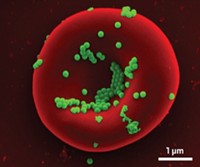Advertisement
Grab your lab coat. Let's get started
Welcome!
Welcome!
Create an account below to get 6 C&EN articles per month, receive newsletters and more - all free.
It seems this is your first time logging in online. Please enter the following information to continue.
As an ACS member you automatically get access to this site. All we need is few more details to create your reading experience.
Not you? Sign in with a different account.
Not you? Sign in with a different account.
ERROR 1
ERROR 1
ERROR 2
ERROR 2
ERROR 2
ERROR 2
ERROR 2
Password and Confirm password must match.
If you have an ACS member number, please enter it here so we can link this account to your membership. (optional)
ERROR 2
ACS values your privacy. By submitting your information, you are gaining access to C&EN and subscribing to our weekly newsletter. We use the information you provide to make your reading experience better, and we will never sell your data to third party members.
Materials
How Iron Makes Silica Nanoparticles Biodegradable
Doping nanosized silica with iron(III) makes the persistent particles biodegradable
by Carmen Drahl
August 20, 2012
| A version of this story appeared in
Volume 90, Issue 34
Adding a pinch of iron to silica nanoparticles makes the material degrade more rapidly, chemists at the University of California, San Diego, report (J. Am. Chem. Soc., DOI: 10.1021/ja3036114). The discovery could pave the way to biodegradable forms of silica for ultrasound contrast imaging or drug delivery. Silica’s stability makes it problematic for medical applications. Tiny silica particles can cause health hazards by accumulating in the lungs, and they also linger in the liver and kidneys. Inspired by reports that cations could alter silica’s degradation rate, Kristina K. Pohaku Mitchell, Andrew C. Kummel, William C. Trogler, and Alexander Liberman doped iron(III) into hollow silica nanoshell structures. They surmised that iron-chelating drugs or powerful iron chelators present in living things might snatch iron from silica nanostructures to promote degradation. Sure enough, their iron-doped nanoshells collapsed and broke down after several days in solution, or several weeks in human blood serum, as shown by UV spectroscopy and scanning electron microscopy. They’re now following the fate of silica degradation products and evaluating the nanoshells as ultrasound markers for breast tumors.




Join the conversation
Contact the reporter
Submit a Letter to the Editor for publication
Engage with us on Twitter